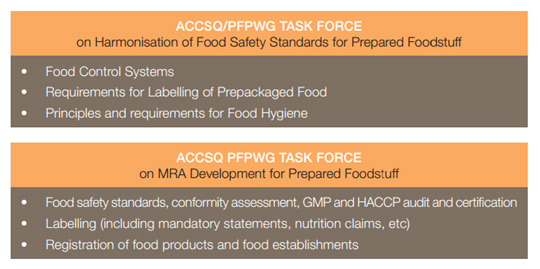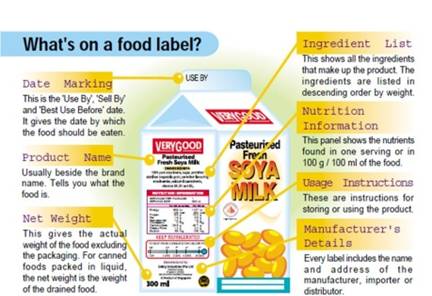Module 15: ASEAN Food Production and Supply
Table of Contents
Reading Text & Presentation
15.3 Regulatory harmonization in ASEAN
The main ASEAN bodies active in respect of harmonization and convergence of food safety and quality standards fall under the leadership of the ASEAN economics ministers. The ASEAN Consultative Committee on Standards and Quality (ACCSQ) is the key body responsible for coordinating work on standards and mutual recognition, accreditation and conformity assessment, and sector-specific harmonization efforts. There are two task forces that have been established to support the work of the ACCSQ: ACCSQ/PFPWG in respect of harmonization of food safety standards for prepared foodstuffs, and ACCSQ/PFPWG on MRA development for prepared foodstuffs. They cover the following topics:

ACCSQ PFPWG Task Force
(Source: http://www.eria.org/ERIA-DP-2013-30.pdf retrieved 29/4/2014)
15.3.1 ASEAN Requirements for Food Labeling
ASEAN member states are required to contain the following information on packaged food:
| 1) Claim is particular quality relating to its origin, nutritional properties, nature, processing, composition or any other quality. |
2) Date of minimum durability or best before date is the date under any stated conditions during which the product will remain fully marketable and will retain any specific qualities. |
3) Expiry date or use by date is the date estimated period under stated storage conditions during as after this date, the food should not be regarded as marketable. |
4) Food is any substance, whether processed, semi-processed or raw. It is intended for human consumption, and includes drinks, chewing gum and any substance which has been used in the manufacture, preparation or treatment of ‘food’. However, it does not include cosmetics, tobacco or substances used only as drugs. |
5) Food additive is any substance that is not normally consumed as a food by itself, used for a technological purpose in the manufacture, processing, preparation, treatment, packing, packaging, transport or holding of such food results, or may be reasonably expected to result, (directly or indirectly) in it or its by-products. |
6) Ingredient is any substances used in the manufacture or preparation or treatment of a food and may be present in the final products although possibly in a modified form. |
7) Label is any, tag, brand, mark, symbol, logo, pictorial or other descriptive matter written, printed, stencilled, marked, embossed or impressed on, or attached to a container of food or accompanying any food including that for the purpose of promoting its sale or disposal.
|
(Source: Adapted from http://storage.globalcitizen.net/data/topic/knowledge/uploads/20120117133356533.pdf retrieved 28/4/2014)
15.3.2 Components of a food label
Food labels are useful in helping you make informed choices when buying food products. Labeling of all prepackaged foods generally includes requirements for ingredient labeling, nutrition labeling, durable life dates, nutrient content claims, health claims and foods for special dietary use.
There are 7 components of a food label:

Food label components
(Source: https://www.ktph.com.sg/hllibrary/display/936/reading_food_labels retrieved 10/4/2014)
Note: More useful links and information can be found in the Resources section.
Language Focus 15.3
Activities
Activity 9Activity 10Activity 11Activity 12